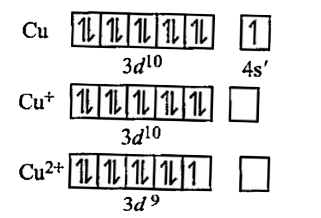Why Cu(l) is colourless and Cu(ll) is blue in colour ?Solution in Punjabi
Transition Element : These are the substances which have partially filled d-subshell is called transition element.
Now, Electronic configuration of Cu (Atomic No. 29) is.
1s22s22p63s23p63d104s1

Cu (I) is colourless because they have fully filled d-subshell so d-d transition is not possible. But Cu (II) is Blue in colour because there·is possible d-d Transition and have partilly filled d-subshell so, they show colour.
Topper's Solved these Questions
Similar Questions
What is mutarotation ?
01:17View SolutionICI7 does not exist while IF7 exist. Why ?
02:48View Solution$ CuS is blue in colour.
! All Cu2+ salts are blue in colour.View SolutionAqueous Cu^(2+) ions are blue in colour, where as Aqueous Zn^(2+) ions are colourless. Why ?
04:02View SolutionExplain why compounds of Cu2+ are coloured but those of Zn2+ are colourless.
01:48View SolutionCu^(+) salts are colourless but Cu^(2+) salts are coloured. Give reasons.
06:55View SolutionThe colour of the solution turns blue when a Cu - plate is dipped in a colourless solution of -
02:53View SolutionExplain why [Cu(NH_(3))_(4)]^(2+) is coloured but [Cu(CN)_(4)]^(3-) is colourless.
03:00View SolutionExplain why Cu(NH3)4]2+ ion is coloured but [Cu(CN)4]3− ion is colourless.
View SolutionA: Copper rod turns colourless solution of zinc sulphate to blue.
R: Zinc reduce Cu2+ ions to Cu+02:22View SolutionExplain why compounds of Cu^(2+) are coloured but those of Zn^(2+) are colourless.
01:49View SolutionWhy are Cu(I) salts colourless ?
04:03View SolutionWhy Cu(l) is colourless and Cu(ll) is blue in colour ?
03:54View SolutionCu+ ion is colourless. Why?
02:14View Solution[Cu(NH3)4]2+ ion is coloured while [Cu(CN)4]3− ion is colourless why ?
03:25View SolutionWhy Cu^(+) salts are colourless ?
02:14View Solution

